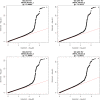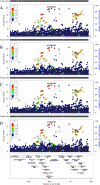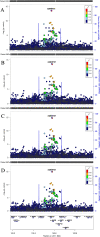Genome-wide association study identifies novel loci associated with skin autofluorescence in individuals without diabetes
- PMID: 36536295
- PMCID: PMC9764523
- DOI: 10.1186/s12864-022-09062-x
Genome-wide association study identifies novel loci associated with skin autofluorescence in individuals without diabetes
Abstract
Background: Skin autofluorescence (SAF) is a non-invasive measure reflecting accumulation of advanced glycation endproducts (AGEs) in the skin. Higher SAF levels are associated with an increased risk of developing type 2 diabetes and cardiovascular disease. An earlier genome-wide association study (GWAS) revealed a strong association between NAT2 variants and SAF. The aim of this study was to calculate SAF heritability and to identify additional genetic variants associated with SAF through genome-wide association studies (GWAS).
Results: In 27,534 participants without diabetes the heritability estimate of lnSAF was 33% ± 2.0% (SE) in a model adjusted for covariates. In meta-GWAS for lnSAF five SNPs, on chromosomes 8, 11, 15 and 16 were associated with lnSAF (P < 5 × 10-8): 1. rs2846707 (Chr11:102,576,358,C > T), which results in a Met30Val missense variant in MMP27 exon 1 (NM_022122.3); 2. rs2470893 (Chr15:75,019,449,C > T), in intergenic region between CYP1A1 and CYP1A2; with attenuation of the SNP-effect when coffee consumption was included as a covariate; 3. rs12931267 (Chr16:89,818,732,C > G) in intron 30 of FANCA and near MC1R; and following conditional analysis 4. rs3764257 (Chr16:89,800,887,C > G) an intronic variant in ZNF276, 17.8 kb upstream from rs12931267; finally, 30 kb downstream from NAT2 5. rs576201050 (Chr8:18,288,053,G > A).
Conclusions: This large meta-GWAS revealed five SNPs at four loci associated with SAF in the non-diabetes population. Further unravelling of the genetic architecture of SAF will help in improving its utility as a tool for screening and early detection of diseases and disease complications.
Keywords: Coffee; Genome-wide association study; Screening; Single nucleotide polymorphism; Skin Autofluorescence; Skin Pigmentation.
© 2022. The Author(s).
Conflict of interest statement
The authors declare that they have no competing interests.
Figures






References
-
- Schmidt AM, Hori O, Brett J, Shi Du Yan, Wautier JL, Stern D. Cellular receptors for advanced glycation end products: Implications for induction of oxidant stress and cellular dysfunction in the pathogenesis of vascular lesions. Arterioscler Thromb 1994;14:1521–8. 10.1161/01.atv.14.10.1521. - PubMed
-
- Meerwaldt R, Hartog JWL, Graaff R, Huisman RJ, Links TP, den Hollander NC, et al. Skin Autofluorescence, a Measure of Cumulative Metabolic Stress and Advanced Glycation End Products, Predicts Mortality in Hemodialysis Patients. J Am Soc Nephrol. 2005;16:3687–3693. doi: 10.1681/ASN.2005020144. - DOI - PubMed
MeSH terms
Substances
LinkOut - more resources
Full Text Sources
Medical
Miscellaneous

